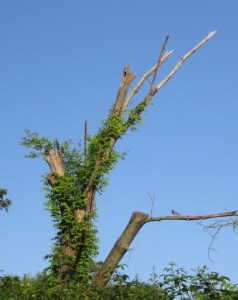By Edie Parnum
Looking out my kitchen window as I habitually do, I spotted a large dark bird showing bold white flashes on its wings flying to a snag at the back of my property. Luckily, I keep my binoculars within reach on the counter. It was a Pileated Woodpecker, a first for my yard.
This Pileated Woodpecker was #105 on my Yard Bird List. Every new bird added to the list is special to me. My count makes me proud that I’ve planted bird-friendly natives that host a variety of birds. However, because my young trees are too immature to attract this woodpecker, the pileated was a surprise. It visited my yard because I left the trunk and some major branches on a dead tree rather than cut it to the ground.

The snag in Edie’s yard that attracted the Pileated Woodpecker. Photo by Edie Parnum. Click to enlarge.
Keeping the yard list helps me hone my ID skills, visual and auditory. A Least Flycatcher, one of those challenging
Empidonax flycatchers, once lingered in my yard for two days. Seated on my deck, I could leisurely, but closely observe its diagnostic bold eye-ring, big head, short wings, and narrow tail. It did not sing, but occasionally gave a call, a little “pit” sound. If I had been elsewhere on a bird walk, I
would have made a quick ID and quickly moved on to look for other birds.
Closely watching the birds in my ¾-acre yard improves my knowledge of their habits, food preferences, seasonality, and habitat requirements. I note the species of birds using each plant and the time of year. In the spring, warblers, vireos, orioles, and other migrants glean caterpillars from the foliage of my Black Cherry and the young oaks and birches. In the fall, waxwings, mockingbirds, woodpeckers, robins, and other thrushes devour the crabapples. A variety of sparrows eat seeds in my 1/10-acre meadow in the autumn. Yellow-bellied Sapsuckers bore holes in the Sweet Gum and crabapples in the spring and fall. A Magnolia Warbler foraged in the Northern Bayberry last September, but I’m not sure whether it was eating the berries or bugs. I’ll take a closer look if it returns to the same shrubs next fall.
Do I count birds that fly over my yard without landing, you might ask? Yes, although I can’t claim my improved habitat offers any sustenance to the flyovers. Furthermore, I even added a distant, heard-only, Fish Crow to my list. Perhaps I’m inflating my yard count, but I’m staying observant of all the birdlife around me. On the other hand, I didn’t count a Red-shouldered Hawk perched three blocks away that never flew over my property.
I keep a list of missing birds, too. I haven’t seen a Willow Flycatcher, Veery, or a White-eyed Vireo —how could that be?! Lacking a stream or wetland on my property, I may never see a Louisiana and Northern Waterthrush. Mature native trees are still scarce here, so the warbler list is slim–just 20 species. Maybe during this fall migration or next spring I’ll find the missing Orange-crowned, Tennessee, Cerulean, Bay-breasted, Connecticut, Mourning, Wilson’s, or Hooded Warbler. I probably won’t ever get an outlier like American Woodcock (wrong habitat), but I have hopes that a Northern Saw-Whet Owl will use my Eastern Red Cedar one day.
Keeping a yard list can be as simple as noting the birds on a piece of paper. Or, even better, you can use eBird, a listing program that is one of the Cornell University Laboratory of Ornithology’s citizen science projects. By entering your yard bird sightings into eBird, you’ll have access to the records of other local as well as far-flung birders. Your data will be incorporated into Cornell’s records and be used to track bird populations by educators, conservationists, and ornithologists around the world. http://ebird.org/content/ebird/ or http://ebird.org/content/pa/
Watching for birds is a part of my everyday life. I can observe my feeder birds while working at my kitchen sink. As I move around the house, I always glance out the closest window. While relaxing on my deck, I’ve spotted many new yard birds. I regularly take walks around the yard, too. On good migration days, I go out early to look for new arrivals. No travel is necessary, and there’s still time for the rest of the day’s activities. Every day I’m connected to nature.


